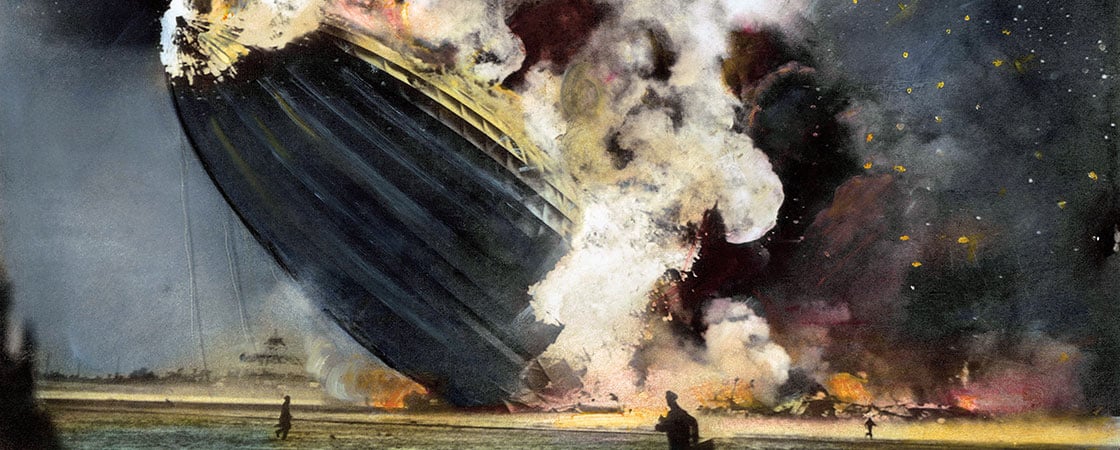Hindenburg Contest
Imagine you are Werner as a grown man. In a letter, tell your children what caused the Hindenburg to crash, and how it affected the way people traveled afterward. Be sure to include details from the article.

The true and tragic story of the Hindenburg, the greatest flying machine ever built.

Learning Objective: Students will read about the explosion and crash that destroyed the Hindenburg in 1937 and its impact on a young crew member. They will identify facts that support the causes and effects of the air disaster, and build vocabulary.
An original map of the Hindenburg’s flight path exists! It was found in the papers of a 24-year-old American survivor. Share this fascinating 3-minute Smithsonian video from a curator who explains how she received the map, and what else came with it. (Note: The first 15 seconds show original news footage of the crash, including the shocked broadcaster’s narration. You might want to start the video after that if you feel it will upset your students.)
If your students are curious about what the inside of the airship looked like, take a look at this article. From photos of the dining room, to the architectural skeleton of the airship, it provides a cool visual aid of the gigantic vessel.
Let your students know that there was another major zeppelin before the Hindenburg. Graf Zeppelin was the first airship to travel to another continent without stopping, and it crossed the Atlantic Ocean 136 times.
The Hindenburg can be compared and contrasted with another disastrous vessel: the Titanic. (Check out our nonfiction story from last year about the Titanic.)
Every “Big Read” nonfiction feature in Storyworks Jr. comes with a writing contest! Check out the “Think & Write” prompt on page 9 and encourage your students to enter the contest—they could win some awesome prizes!
More About the Article
Content-Area Connections
Social studies: world history, United States history, geography
Science: engineering, environment
Key Skills
Text features, vocabulary, key details, author’s purpose, text evidence, drawing conclusions
Reading Workshop Minilesson
minilesson info and link here
1. PREPARING TO READ
Watch a Video/Preview Text Features (25 minutes)
This story is accompanied by a Video Read-Aloud narrated by author Lauren Tarshis. Dramatic photos and footage help students imagine what it was like to be a passenger on the Hindenburg and experience the terrifying explosion and crash. The video can be used as a “first read” to preview the story for the class.
Look at pages 4-5 with the class. Direct students to the title, subhead, and illustrations. Ask: What do you think the story is about? What key words in the title and subhead helped you decide? How do the pictures and captions make you want to read the story?
Direct students to the map and caption on page 6. Have them use the compass rose to identify the direction of the Hindenburg’s flight path across the Atlantic Ocean. Point to New Jersey on a classroom map of the United States.
Look at the remaining images. Discuss the title and caption of each with the class. Ask: Which image would you like to learn more about? Why?
Introduce Domain-Specific Vocabulary (15 minutes)
We have highlighted in bold six words that may be challenging and defined them on the page. Preview these words by projecting or distributing our vocabulary activity and completing it as a class. You can also play our Vocabulary Slideshow.
Highlighted words: spectacular, tragedy, gourmet, flammable, jerked, monstrous
Set a Purpose for Reading (5 minutes)
Read the Think and Read and Think and Write boxes on pages 4 and 9, which support the featured skill, cause and effect. Ask students to look for details as they read that help them identify the causes of the crash and how the disaster affected air travel.
2. CLOSE READING
Reading and Unpacking the Text
First read: Read the story as a class. At the end of each section, use the Pause and Think question to quickly check students’ comprehension.
Second read: Distribute the close-reading and critical-thinking questions to the class. Preview them together. Ask students to read the article again and answer the questions as a class or in small groups.
Close-Reading Questions (30 minutes)
Critical-Thinking Question (10 minutes)
3. SKILL BUILDING
Distribute our Cause and Effect activity. Have students work in small groups to complete the activity.
Discuss the writing assignment in the Think and Write box on page 9. Review the format of an informal letter with the class. Remind students to use the first-person pronoun I, since Werner is talking about his own experiences. Students can share their letters in small group
Ask students to reread the article and underline interesting facts about the disaster. Have them write three questions they would have asked Werner Franz after the crash. Call on students to share their questions in small groups.
Have reading pairs role-play interviews between a newspaper reporter and either a Hindenburg passenger, a crew member, or a family member who saw the zeppelin crash. Have pairs present their role-plays in class.
Read the lower-Lexile version of the article as students follow along. Ask them to use sticky notes to mark interesting details about the Hindenburg. Which detail surprised them the most? Which would they like to learn more about?
Ask students to write the first paragraph of a 1937 newspaper article about the Hindenburg. They can use facts from the article and quotes from passengers and spectators. (These quotes can be made-up.)